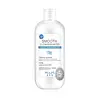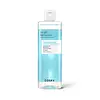What's inside
What's inside
 Key Ingredients
Key Ingredients

 Benefits
Benefits

 Concerns
Concerns

No concerns
 Ingredients Side-by-side
Ingredients Side-by-side

Water
Skin ConditioningDipropylene Glycol
HumectantPoloxamer 184
EmulsifyingSorbitol
HumectantPEG-6 Caprylic/Capric Glycerides
EmulsifyingGlycerin
HumectantButylene Glycol
HumectantCichorium Intybus Leaf Extract
MaskingBrassica Oleracea Italica Extract
AstringentApium Graveolens Extract
Skin ConditioningSodium Polyacrylate
AbsorbentSodium Chloride
MaskingCaprylhydroxamic Acid
1,2-Hexanediol
Skin ConditioningPhenoxyethanol
PreservativeBetaine
HumectantDisodium EDTA
Sodium PCA
HumectantSerine
MaskingSodium Hyaluronate
HumectantGlutamic Acid
HumectantAlanine
MaskingLysine
Skin ConditioningArginine
MaskingThreonine
Opuntia Ficus-Indica Stem Extract
Skin ConditioningGlycine
BufferingProline
Skin ConditioningPolyglutamic Acid
Skin ConditioningWater, Dipropylene Glycol, Poloxamer 184, Sorbitol, PEG-6 Caprylic/Capric Glycerides, Glycerin, Butylene Glycol, Cichorium Intybus Leaf Extract, Brassica Oleracea Italica Extract, Apium Graveolens Extract, Sodium Polyacrylate, Sodium Chloride, Caprylhydroxamic Acid, 1,2-Hexanediol, Phenoxyethanol, Betaine, Disodium EDTA, Sodium PCA, Serine, Sodium Hyaluronate, Glutamic Acid, Alanine, Lysine, Arginine, Threonine, Opuntia Ficus-Indica Stem Extract, Glycine, Proline, Polyglutamic Acid
 Reviews
Reviews

Ingredients Explained
These ingredients are found in both products.
Ingredients higher up in an ingredient list are typically present in a larger amount.
1,2-Hexanediol is a synthetic liquid and another multi-functional powerhouse.
It is a:
- Humectant, drawing moisture into the skin
- Emollient, helping to soften skin
- Solvent, dispersing and stabilizing formulas
- Preservative booster, enhancing the antimicrobial activity of other preservatives
Dipropylene Glycol is a synthetically created humectant, stabilizer, and solvent.
This ingredient helps:
Dipropylene glycol is technically an alcohol, but it belongs to the glycol family (often considered part of the ‘good’ alcohols). This means it is hydrating and gentle on skin unlike drying solvent alcohols like denatured alcohol.
As a masking agent, Dipropylene Glycol can be used to cover the smell of other ingredients. However, it does not have a scent.
Studies show Dipropylene Glycol is considered safe to use in skincare.
Learn more about Dipropylene GlycolDisodium EDTA plays a role in making products more stable by aiding other preservatives.
It is a chelating agent, meaning it neutralizes metal ions that may be found in a product.
Disodium EDTA is a salt of edetic acid and is found to be safe in cosmetic ingredients.
Learn more about Disodium EDTASodium Hyaluronate is hyaluronic acid's salt form. It is commonly derived from the sodium salt of hyaluronic acid.
Like hyaluronic acid, it is great at holding water and acts as a humectant. This makes it a great skin hydrating ingredient.
Sodium Hyaluronate is naturally occurring in our bodies and is mostly found in eye fluid and joints.
These are some other common types of Hyaluronic Acid:
Learn more about Sodium HyaluronateWater. It's the most common cosmetic ingredient of all. You'll usually see it at the top of ingredient lists, meaning that it makes up the largest part of the product.
So why is it so popular? Water most often acts as a solvent - this means that it helps dissolve other ingredients into the formulation.
You'll also recognize water as that liquid we all need to stay alive. If you see this, drink a glass of water. Stay hydrated!
Learn more about Water